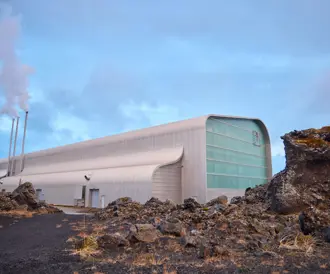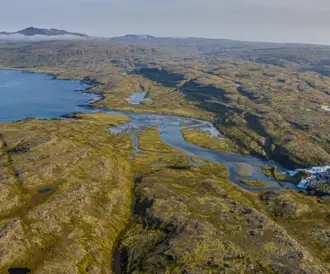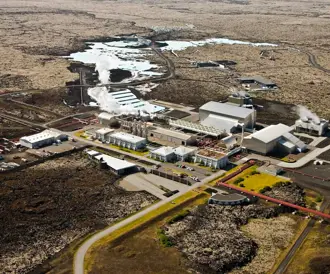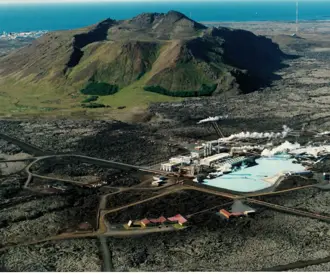A Brief History of HS Orka
Icelanders have a long history of utilizing geothermal energy and have always been alert to potential opportunities related to it. In the 1960s and 1970s, forward-thinking individuals noticed that snow always melted at certain spots in Svartsengi on the Reykjanes Peninsula. At a town council meeting in Keflavík on May 26, 1959, a committee was elected to look into the possibilities of a district heating system in Keflavík. Later that year, a district heating committee was also elected in Njarðvík. In 1969, the Grindavík municipal council decided to initate research in the Svartsengi area for geothermal energy to be harnessed for heating homes in Grindavík.
Geophysical measurements and two shallow high-temperature production wells near Grindavíkurvegur revealed a workable and productive geothermal resource in the area. It was a high-temperature area where the temperature was over 200°C at depths below 1,000 meters, but the water that came up from the wells was salty, about 2/3 of the salinity of seawater. Due to the salinity, temperature, and dissolved minerals, it was clear that the water could not be used directly as was the case in Reykjavík and most other places, but heat exchange methods had to be developed to utilize the geothermal energy.
The Formation of Hitaveita Suðurnesja
The municipalities on the Reykjanes Peninsula joined forces with the Icelandic state, and on December 31, 1974, Hitaveita Suðurnesja was established by law from the Althingi (Icelandic Parliament). The state provided research boreholes in the area and various geothermal research, while the people of the Reykjanes Peninsula provided funding and manpower. Scientists from the National Energy Authority proposed production techniques, and an experimental station was set up to verify the ideas and lay the foundation for the design criteria for a geothermal power plant. There were no models to follow from abroad.
In 1975, the first fresh groundwater well was drilled, and a heat exchange station was built in Svartsengi. That same year, Ingólfur Aðalsteinsson, a meteorologist, was hired as the company’s first employee and soon he took over as its director. Ingólfur held the position until 1992 when Júlíus Jónsson, the financial manager, took over. He was the director of Hitaveita Suðurnesja and later both HS Orka and HS Veitur until 2014. Ásgeir Margeirsson, an engineer, was then appointed CEO of HS Orka and held the position until 2019, while Júlíus continued to lead HS Veitur until 2022. Finnur Beck, a lawyer, briefly served as CEO of HS Orka in 2019 until Tómas Már Sigurðsson, an planning engineer, took over the position later that year.
A Successful Prototype
In 1976, a temporary station was set up, heating fresh, clean groundwater with geothermal water and steam from high-temperature boreholes. It proved to be a successful prototype that delivered heated water of acceptable quality. The community center Festi in Grindavík received the first district heating water. That same year, the first phase of the geothermal plant in Svartsengi was initiated. This phase consisted of two steam turbines, which produced electricity, and four heat exchange and degassing circuits for hot water production. The connection of these two different production processes for electricity and hot water production exceeded expectations and significantly improved the energy utilization of the geothermal resource.
Electricity Production Begins in Svartsengi
In the years around 1980, water shortages in the highlands caused such problems in Landsvirkjun’s electricity production that most backup diesel generators in the country had to be run to meet the energy needs of residents and businesses. This situation led Hitaveita Suðurnesja to start producing electricity directly into the national grid, making Svartsengi an “unofficial” power plant.
Nearly a decade later, seven 1.2 MW Ormat machines were installed in Svartsengi for electricity production. These machines use excess steam from other plant machines, thus significantly improving the resource utilization. This arrangement was the first of its kind in the world at that time.
Expanding the District Heating System
The early years of Hitaveita Suðurnesja were characterized by a small workforce. Along with contractors, the staff handled the maintenance of the district heating system and geothermal plants, but various challenges and significant design flaws arose due to inexperience.
In 1982, Hitaveita Suðurnesja purchased all the assets of RARIK on the Reykjanes Peninsula. The company took over the operation of the area’s distribution and high-voltage systems, as well as a converter station that supplied electricity to the NATO defense force and the airport terminal at Keflavík Airport. This marked a turning point in the reliability of electricity supply in the area. Underground cables replaced poor overhead lines, new high-voltage cables were laid underground, and new substations were built.
The Resource Park Established
As the company’s operations expanded, the Resource Park of Hitaveita Suðurnesja began to take shape, and in 1992, the Blue Lagoon was established. It is one of the oldest examples of a company in the Resource Park utilizing different resource streams from geothermal production in Svartsengi. The Resource Park is based on the philosophy of Albert Albertsson, an engineer, thinker, and former deputy CEO of HS Orka, who learned at a young age to respect nature and make the most of everything in a sustainable manner.
Reykjanes Power Plant
Hitaveita Suðurnesja became a limited company in 2000, beeing the first Icelandic energy company to do so. In 2003, the company took over the Suðurnes Water Utility, becoming a district heating utility, water utility, electricity utility, electricity producer, and electricity seller all in one. The company continued to develop geothermal production and became a world leader in its field.
Construction began on the Reykjanes Power Plant, and in the spring of 2006, the plant was commissioned with two 50 MW steam turbines. This made the Reykjanes Peninsula home to two power plants. Unlike the geothermal plant in Svartsengi, the Reykjanes Power Plant is solely an electricity plant, consisting of dual-flow turbines with seawater-cooled condensers, a novel system in Iceland at the time of its construction.

HS Orka Formed
In 2008, Hitaveita Suðurnesja was dissolved in its existing form, the company’s name was changed to HS Orka, and a new company, HS Veitur, was established. The split was made following the Electricity Act in 2003, which required the separation of electricity production and distribution. HS Orka was to handle electricity production and sales, while HS Veitur was responsible for electricity distribution and the sale and distribution of hot and cold water. The companies continued to share office space at Brekkustígur in Reykjanesbær until 2016, when HS Orka moved its headquarters to Eldborg in Svartsengi.
New Hydropower Projects
In addition to geothermal production, HS Orka began seeking opportunities in hydropower. In 2014, the company became a shareholder in VesturVerk in Ísafjörður, which is preparing a 55 MW hydropower plant in Hvalá in Ófeigsfjörður in the Westfjords, along with other hydropower projects in the Westfjords. Construction began on the company’s first hydropower plant at Brú in Biskupstungur in South Iceland, and Brú Power Plant was officially commissioned in 2021. In 2023, the company also acquired Fjarðará Power Plants in Seyðisfjörður. Brú Power Plant and Fjarðará Power Plants together produce nearly 20 MW.

Reykjanes Power Plant Expanded
A 30 MW expansion of the Reykjanes Power Plant was undertaken, and the expansion was commissioned at the end of 2022. The project is unique globally, utilizing the innovation of staff and local experts to continue harnessing the resource. It can be said that the environmental impact of the expansion is minimal, as the philosophy is to fully utilize the energy and fluids extracted from the ground. Instead of new boreholes, a method was developed to continue utilizing the resource by capturing waste heat from the plant.
Challenging Coexistance with Nature
In March 2021, volcanic eruptions broke out on the surface of the Reykjanes Peninsula near Fagradalsfjall. HS Orka outlined various scenarios and developed comprehensive response plans to protect the production of energy if the geological activities moved closer to the geothermal plants. This became a reality on November 10, 2023, when events began near the Sundhnúkur crater row, close to the town of Grindavík and operations in Svartsengi, with no end in sight.
There have been numerous eruptions on the Reykjanes Peninsula since March 2021, each having various impacts on the community and infrastructure on the Reykjanes Peninsula. In January 2024, lava flowed over Grindavíkurvegur, severing power lines and burning underground cables nearby. A month later, lava severed the main district heating pipeline from Svartsengi to Fitjar (the Njarðvík branch), causing a hot water shortage across the Reykjanes Peninsula. In both cases, the combined efforts of many individuals managed to reconnect pipes and cables in remarkably short time under difficult conditions and in severe cold.
The challenges have also led to innovation. Through various pressure measurements in the company’s boreholes, HS Orka scientists have developed a unique warning system to predict volcanic eruptions. Decades of pioneering thinking within HS Orka have thus been well utilized in solving various difficult tasks arising from the volcanic activity.
Expansion and Improvements in Svartsengi
Construction on the expansion and improvements of the geothermal power plant in Svartsengi is currently underway, despite the recent seismic and volcanic activity on the Reykjanes Peninsula, and the project is progressing well.
The project involves decommissioning older production units and installing a new production unit in their place. This will improve resource utilization and increase the plant’s production capacity to 85 MW, up from the current installed capacity of about 66 MW. Additionally, the production capacity for hot water will increase, better meeting the needs of the growing population in the area.
The project is similar in size to the expansion of the Reykjanes Power Plant, which was commissioned at the end of 2022, with a total cost estimated at around twelve billion ISK. The aim is to complete the project by the end of 2025.
For a more detailed history of Hitaveita Suðurnesja, the predecessor of HS Orka, you can refer to the historical summary maintained by HS Veitur.

